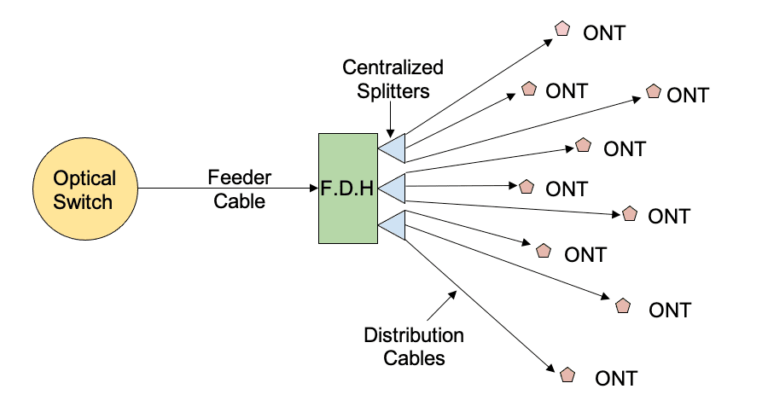In our latest webinar we examined the various methods and architectures in designing and planning FTTx networks. There are pros and cons to each. This article will focus on fiber to the home (FTTH) networks using a centralized-split architecture and its advantages and disadvantages.
First, let’s define FTTH. This terminology is used to describe a broadband network that connects end users (subscribers) to the outside world (internet) with a complete, connected fiber-optic plant consisting of optical switch locations, splitters, fiber cables, and optical network terminals (ONT). Centralized-split architecture refers to a method that groups splitters—typically 1×32—at one location to serve geographically clustered service locations. These splitter locations are typically called fiber distribution hubs (FDH) and are connected with feeder cables to the optical switch.

Method Weaknesses:
- Multiple distribution cabinets – Cabinets serve between 72-576 end users and cost between $10k-20k per cabinet
- Dedicated feeder cables – Typically, the feeder cables are separate cables that run directly from the switch to the cabinets, requiring dual-cable construction along many routes in the network.
- Pre-planning and design – Regional areas need to be fully planned and designed before construction begins.
Method Strengths:
- Minimizes outage potential – Outages can be minimized to small groups within the network by centralizing areas to small wire centers.
- Allows for optimal growth – FDH areas can be broken down into smaller areas within each cluster if growth happens. Most designs account for 30% growth in the distribution network.
- Minimizes large-count cables – Designs can be cost-optimized by setting parameters to use standard-size cables and splice cases, making logistics and ordering easier and cheaper.
- Central location for devices and panels – Operations and maintenance require only one location to connect and troubleshoot.
As with any type of planning and strategy, there is no one-size-fits-all solution. Service operators should think about unique aspects of their network goals before deciding on any architecture. Time to market, initial capital cost, operations, installations, maintenance, and future growth should be examined before making a decision. Although centralized-split architecture takes more up-front planning, it allows for the most efficient network in the long run for operations, maintenance, and growth. At the end of the day, service providers seek to reduce capital expenses, optimize operational expenses, and design a future-proof network that is adaptable to new technologies without substantial change.
For help with your communications networks needs, contact one of our experts today






